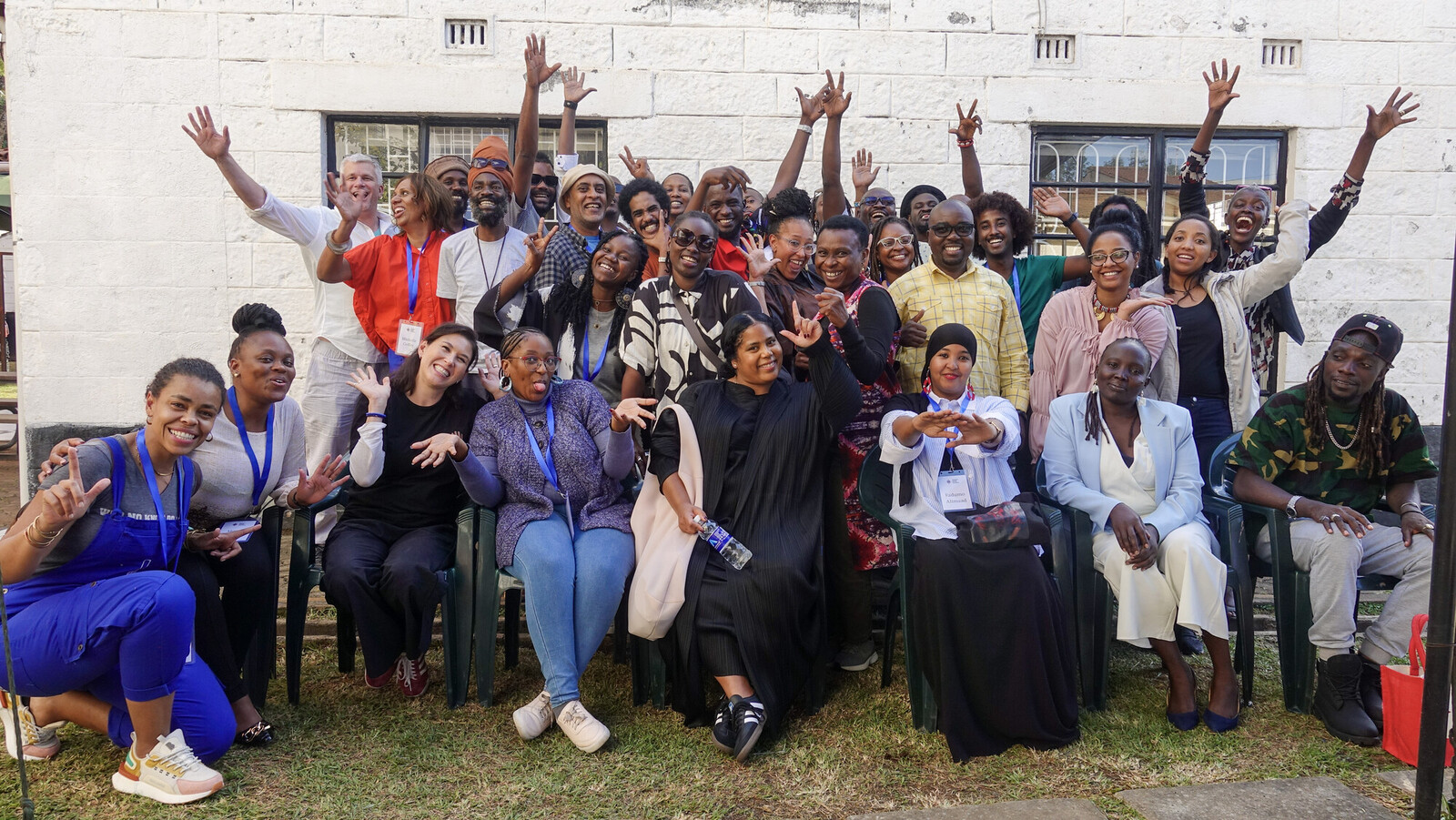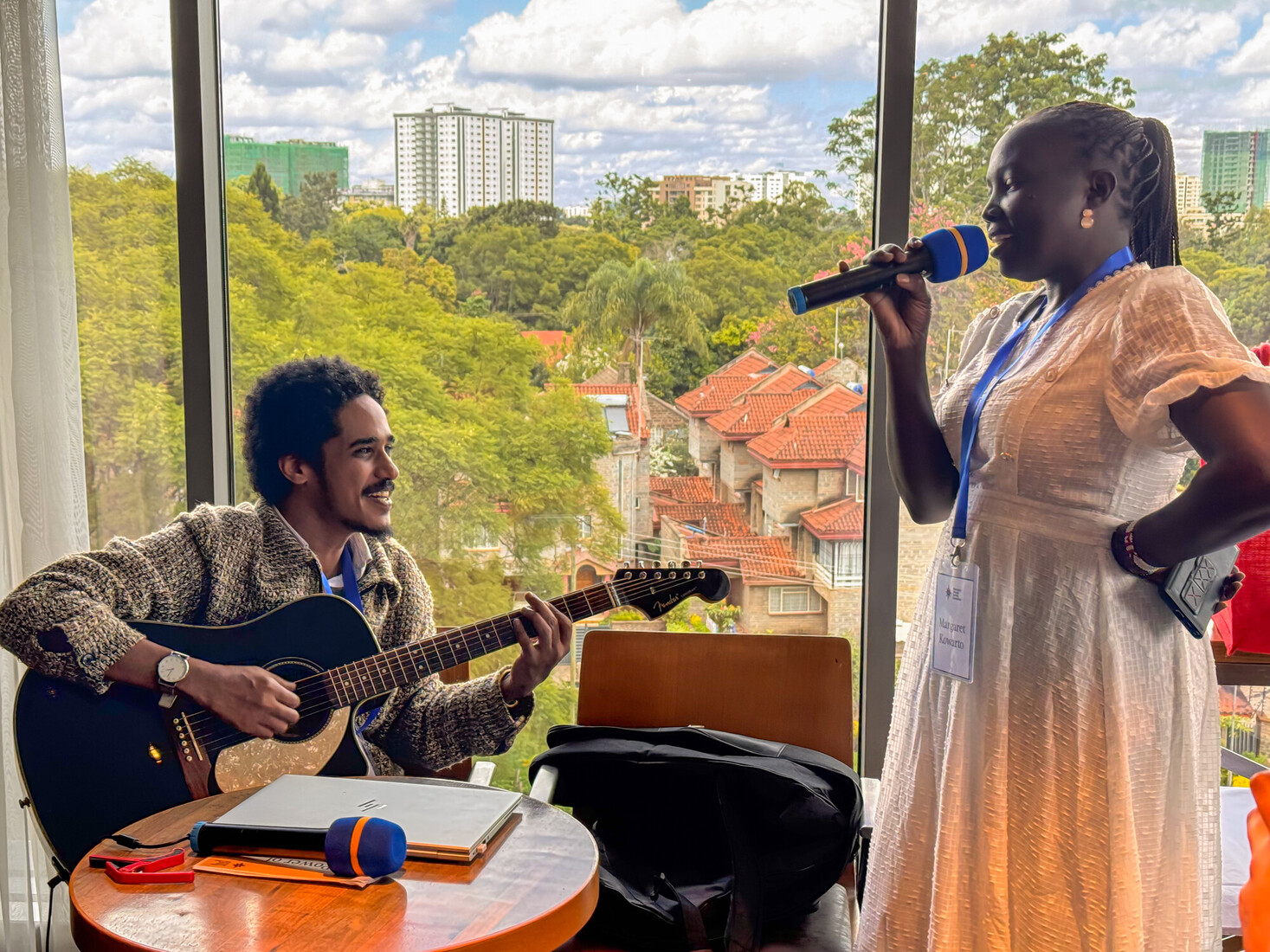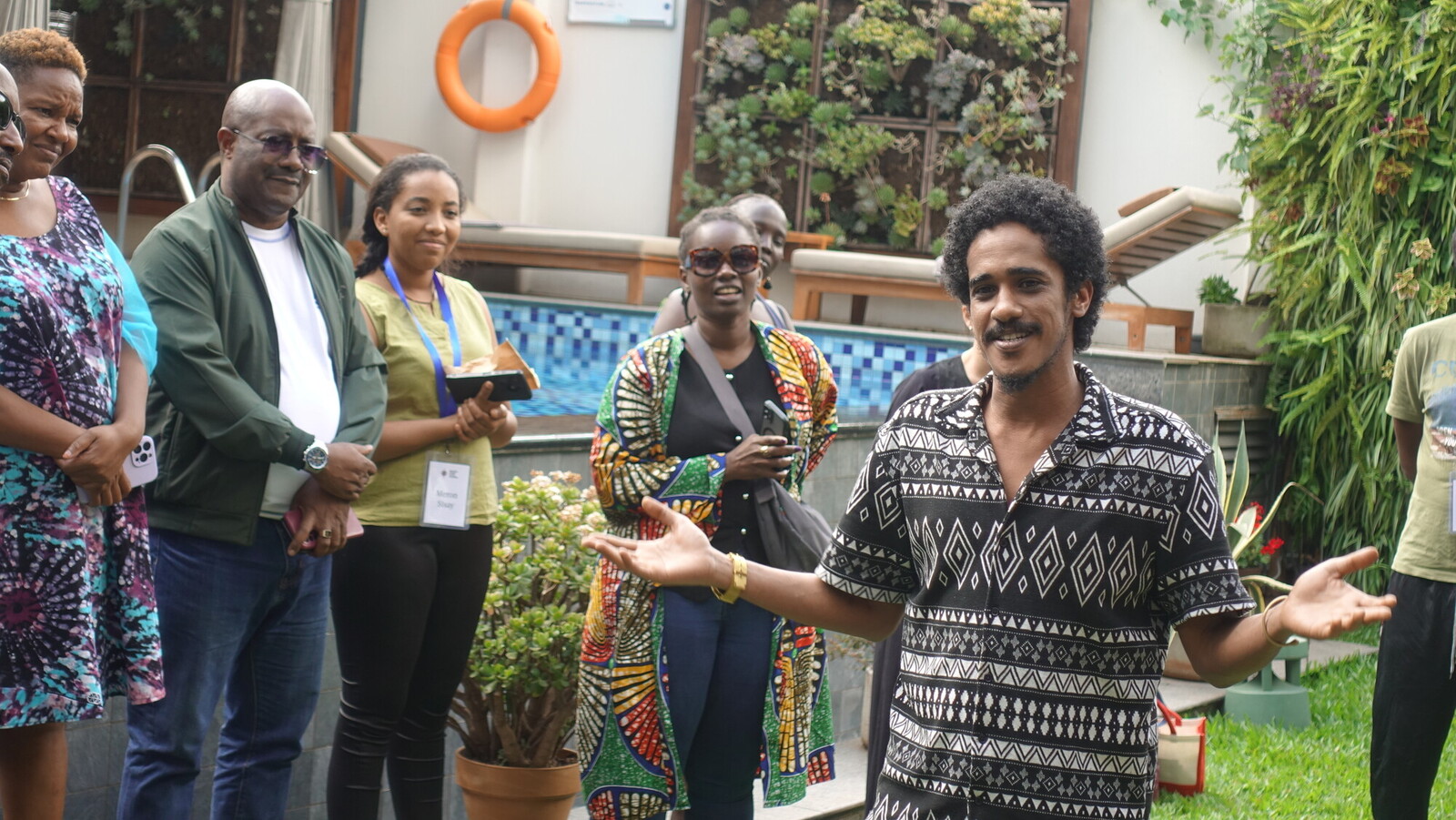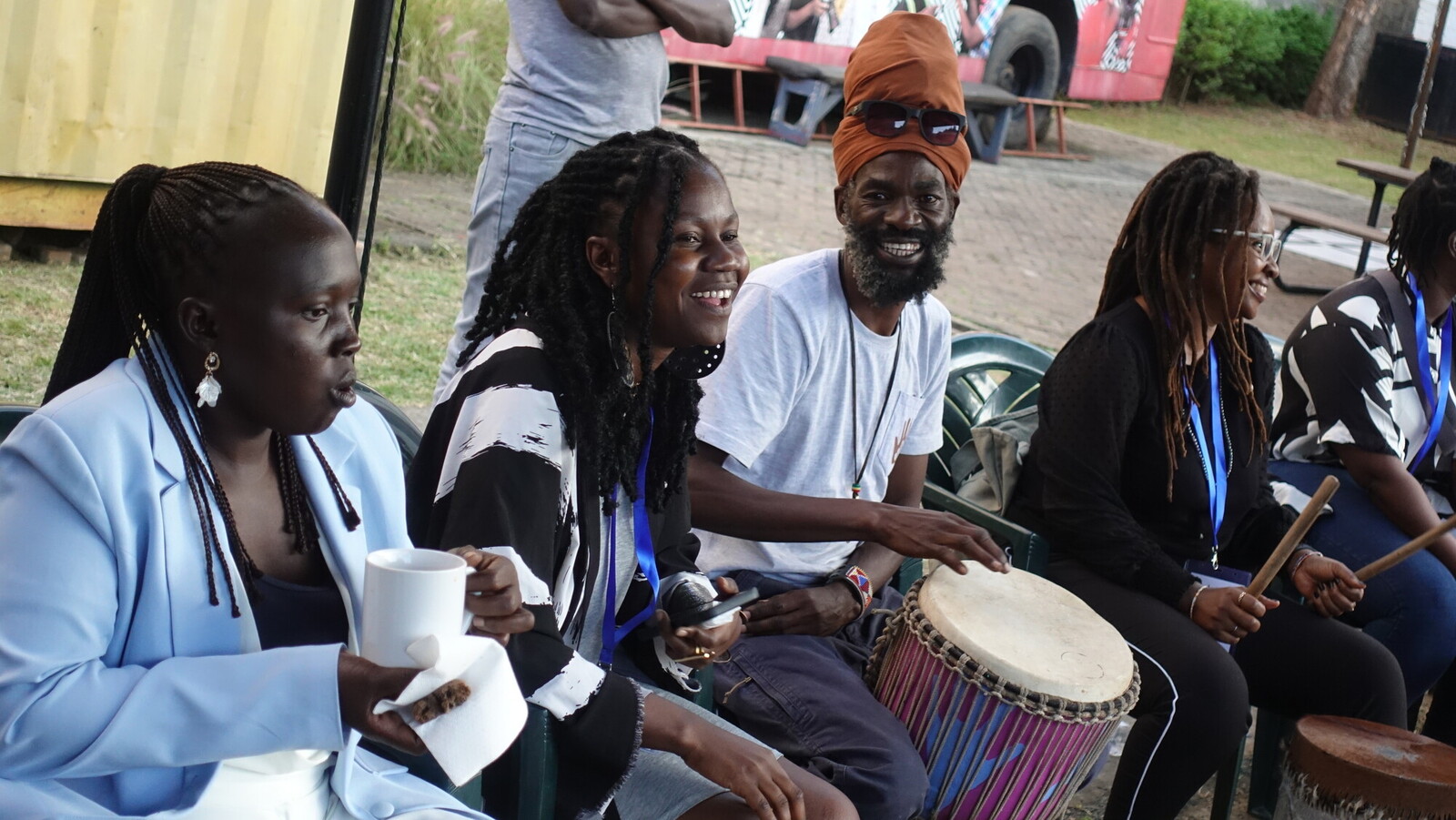
Photo: Bilal A Qureshi
Nestled five floors above the forests of Nairobi’s Lavington neighborhood, 19 artists from countries across Africa gathered at the start of an East African summer to explore the healing power of art. Amid roundtables and PowerPoint presentations, there were inevitable improvisations: hand-drawn sketches on notepads, clay sculptures assembled from found materials, guitar picks, the melodic reverberations of laughter and tears. As art’s power was discussed, art was also made.
A question coursing through the corridors, conversations, and performances that unfolded over three days in May 2025 was posed by the Namibian performance artist and academic Nashilongweshipwe Mushaandja: Can the African drum, both as an instrument and as a metaphor for living consciousness, still suggest a way beyond the silence of suffering? Different languages in Africa imbue the word for drum—ngoma—with varied meanings, he explained, but in each translation the instrument is a physical force for infinite and expansive spiritual power. In drumming and thinking together, could a new circle be forged?
The conference, titled “The Power of Arts and Culture for Healing,” was born of a collaboration between the Philadelphia-based American Friends Service Committee, a 108-year-old Quaker organization with a commitment to quiet diplomacy and nonviolence, and the Johannesburg-based consultancy Andani.Africa. Previous artist convenings had focused on the Middle East and North Africa, but these inaugural Nairobi dialogues were a pan-African exploration of a pressing question with global ramifications: Where politics so often fall short, can art and artists serve as restorative guides?

Photo: Bilal A Qureshi
Artists were chosen from throughout the continent for their recognized and pioneering practices, including community-led theater in South Sudan and Burundi as well as architectural intervention in Lagos. Nairobi, a city that has endured its own share of political trauma, served as a potent backdrop. In buses and Ubers, the group also embarked on field visits to arts spaces and living communities across this vibrant and complex multicultural metropolis. The contemporary map of Nairobi is a living testament to Kenya’s cycles of trauma and repair, to prior regimes of segregation, colonialism, racism, and class stratification. So many were once forbidden from crossing Nairobi’s racial lines, leaving a new generation that has inherited a city still rife with divisions. The local-born singer and former journalist Sharon Ong’ayo Liboi said that growing up in one of the city’s informal settlements never stopped her from pursuing her dream of using the gift of song to heal herself and others. “Healing, in my work . . . is about using music to soften wounds, restore balance, and affirm the wholeness of our experiences, especially for those navigating generational and systemic trauma,” she said. With her traditional kalimba (thumb piano) in hand and an eloquent knowledge of folk traditions, Liboi sang to her fellow artists in one of the weekend’s most transformative interludes. Her notes seemed to lighten the room, easing the weight of history, politics, and suffering.
In public conversations that blur the personal and the political, the idea of the wounded spirit—of “bodies that keep the score”—has become a recurring theme. But as artists like the Sudanese filmmaker Rafa Renas emphasized, self-care and repair mean something fundamentally different for different cultures and national moments. For those like Renas, care is not simply a matter of healing past wounds but of immediate survival and political expression. Artists working across disciplines agreed that, despite their differences, the ability to heal themselves through the making of art—and through the transmission of the work—heals others in concentric circles of repair. But as Kenya-based cultural worker Suzanne Mieko explained, an artist’s restoration has to be anchored by a supportive ecosystem, one that considers specifically what nurtures, cares for, and heals African artists. In sharing the struggles of creating work, a poignant and palpable bond was formed between those assembled.

Photo: Bilal A Qureshi
Each morning began with a call-and-response from curator Rashida Bumbray’s tambourine. A celebrated practitioner and revivalist of the African American circle shout, she glided through the room singing, “Good morning, everybody,” inviting a call-and-response. She was met with a soaring chorus of answers: “Good morning, Rashida.” The deceptively simple act of harmonized voices turned the room into a theater of connection.
Planned sessions alternated between individual presentations about artistic practices, such as the gentrification and destruction of Ethiopia’s capital city, Addis Ababa, and the post-genocide stages of Rwanda—eventually breaking out into small group huddles and whiteboard thinking exercises. In one of the sessions, the burden of political history and access to resources took center stage. As several participants agreed, postcolonial societies, including most countries in Africa, have generally lacked the resources, formal structures, and programs to provide the ecosystem of financial and psychological support artists require, often leading them to pursue assistance from Western funders, which carries its own burdens. The politics of seeking donors and sustainability—the deep need for basic physical amenities to create work and the freedom to explore new artistic collaborations and new currents—all bubbled to the surface. The vulnerability and freedom to share what is at stake, as well as what it takes to create, hit a raw nerve. Often, what sprang organically from the formal schedule were deep friendships forged from resonances across national borders and contexts, born of mirrored recognition of shared struggles and strategies.

Photo: Bilal A Qureshi
Questions were also asked, among them: With the incessant focus on the African continent’s wounds, was there a way to transform conversations around “generational trauma” into those centered on “generational healing”? Could collective and ancestral practices provide a blueprint for the repair and resilience that yield restoration and renaissance?
Those were the profound questions, framed as open-ended explorations. Over talks, meals, and performances, there was consensus that a new language of healing embedded in ancestral practices had paved the way.
As Ugandan participant Jessica Horn shared in her moving closing remarks, “we Africans” are in possession of surplus resources, “excess fabulosity,” as she humorously described. Systems that result in the need for healing or repair are systems that must be remade.
In the courtyard of Nairobi’s acclaimed GoDown, an arts space for creators and community led by Joy Mboya, a massive circle of chairs had been assembled for a sunset soiree. Beautifully made ngoma stood by like works of sculpture. Then, as if by magic, hands-on percussion began, the circle of dancers rose, and Nashilongweshipwe led an ecstatic concert farewell.
The drum, as he had stated, still held the power.